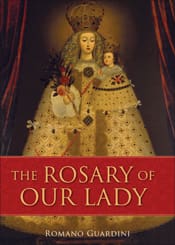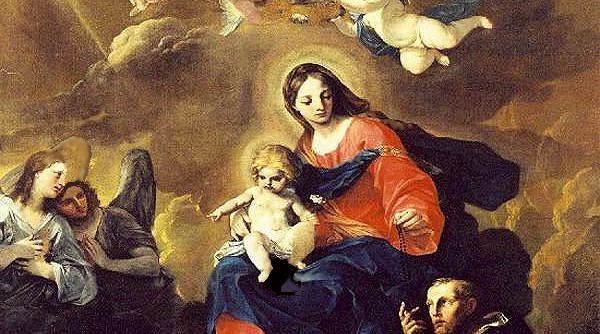The life of Mary, as the Gospel tells it, is as humanly true as it can possibly be, but in this human quality it is filled with a mystery of divine communion and love, the depth of which is unfathomable. The Rosary points in this direction.
Jesus is the substance of Mary’s life, just as the child is the lifeblood of its mother, for whom it is the one and all. But, at the same time, He is also her Redeemer, and that another child cannot be for its mother. Speaking of another child and mother in such a manner is like “making conversation”: as soon as the speech takes a serious turn, it borders on blasphemy. Not only was Mary’s existence as a human mother achieved in her relation to Jesus, but also her redemption. Becoming a mother, she became a Christian. By living with her Child, she lived with the God whose living revelation He is. Growing humanly along with the Child, as do all mothers who really love, releasing Him on the road of life with so much resignation and pain, she ripened in God’s divine grace and truth.
For this reason, Mary is not only a great Christian, one among a number of saints, but she is unique. No one is like her, because what happened to her happened to no other human being. Here lies the authentic root of all exaggeration about her. If people cannot be extravagant enough in their praises of Mary, and even say reckless and foolish things, they are still right in one respect: even though the means are faulty, they seek to express a fact, the tremendous depth of which must overwhelm everyone who realizes it. But exaggerations are useless and harmful, because the simpler the word expressing a truth, the more tremendous and at the same time the more deeply realized do the facts become.
It is Mary on whom the Rosary is centered in a focus ever new. This prayer means a lingering in the world of Mary, whose essence was Christ.
In this way, the Rosary is, in its deepest sense, a prayer of Christ. The first part of the Hail Mary ends with His name: “And blessed is the fruit of thy womb, Jesus.” After this name follow the so-called mysteries (for example, “Whom thou, O Virgin, didst conceive of the Holy Spirit,” “Whom thou didst bear with thee to Elizabeth,” “Who was born to thee in Bethlehem”). Every decade of the Rosary contains such a mystery.
The whole, as it is expressed in the chain of beads, includes five decades and thus forms a cycle of five mysteries. There are three such cycles [Editor’s note: four now with the Luminous mysteries]. The first is the Joyful Rosary; its mysteries deal with the sweetly serene and yet overshadowed youth of Jesus. The second, the Sorrowful Rosary, comprises His Passion from the hour of Gethsemane to His death on the Cross. The third, the Glorious Rosary, deals with the glory of His Resurrection and Ascension, the descent of the Holy Spirit, and Mary’s fulfillment.
We see how, in this prayer, the figure and life of Jesus occupies the foreground: not as He does in the Stations of the Cross, immediate and in itself, but through Mary, as the tenor of His life is seen and sensed by her, “keeping all these things carefully in her heart.”
The essence of the Rosary is a steady incitement to holy sympathy. If a person becomes very important to us, we are happy to meet someone who is attached to him. We see his image mirrored in another life and we see it anew. Our eyes meet two eyes that also love and see. Those eyes add their range of vision to ours, and our gaze may now go beyond the narrowness of our own ego and embrace the beloved being, previously seen only from one side. The joys that the other person experienced, and also the pains he suffered, become so many strings whose vibrations draw from our heart new notes, new understanding, and new responses.
It is intrinsic in the virtue of sympathy that the other person puts his life at our disposal, which enables us to see and to love not only with our own senses but also with his. Something of this sort, only on a higher plane, happens with the Rosary.
+
This article is an excerpt from The Rosary of Our Lady by Romano Guardini, which is available from Sophia Institute Press.
Art for this post on lingering on Mary in the rosary: Modified detail of Virgin and Child with  Angels and Saints [with Rosary], Felice Torelli, 1700s, PD-US author’s term of life plus 100 years or less, Wikimedia Commons. Cover of The Rosary of Our Lady used with permission.
Angels and Saints [with Rosary], Felice Torelli, 1700s, PD-US author’s term of life plus 100 years or less, Wikimedia Commons. Cover of The Rosary of Our Lady used with permission.
To read more about the rosary, click HERE.




